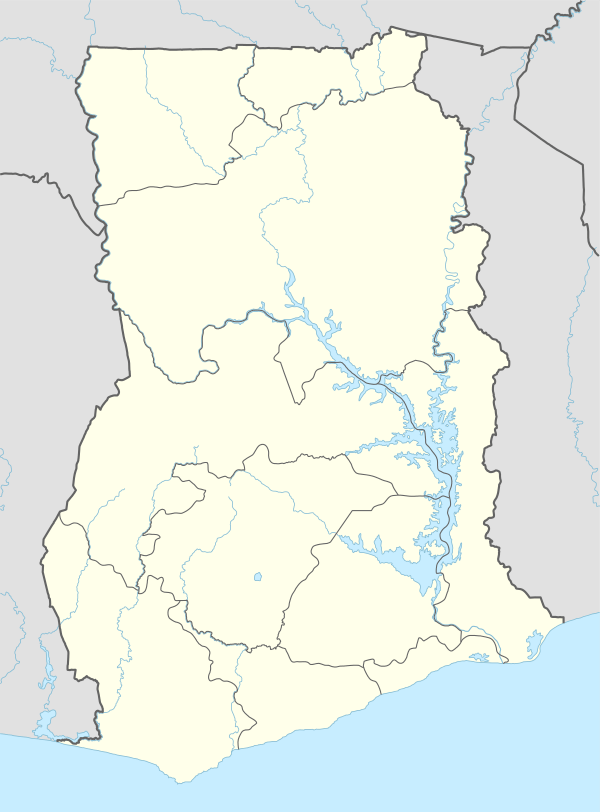Seva, Ghana
| Seva | |
|---|---|
| Town & Municipality Capital | |
 Seva Location in Ghana | |
| Coordinates: 5°59′4.3″N 0°56′29.09″E / 5.984528°N 0.9414139°ECoordinates: 5°59′4.3″N 0°56′29.09″E / 5.984528°N 0.9414139°E | |
| Country |
|
| Region | Volta Region |
| District | Keta Municipal District |
| Population (2012) | |
| • Total | 22,739[1] |
| • Density | 1,829/sq mi (706/km2) |
| Time zone | GMT |
| • Summer (DST) | GMT (UTC) |
| Area code(s) | +233 (3626) |
Seva, Ghana is located in the Keta Lagoon in the Keta District of Ghana. Seva is one of the islands forming the archipelago of the Keta Lagoon. It covers an area of approximately 2.7 square miles. This island is important as a bird watching site because it is a stop over point for many migratory birds. The town has many attractions such as the sandy beaches, general cleanliness and local story telling in Ewe. Historians are unable to get a date for the founding of the town.
History of Seva
The people of Seva are part of the Ewe who migrated from Notsie in the Republic of Togo [2] Seva is divided into north Adziehe and South (Anyiehe) wards in other to accommodate the population which was on the increase. However one can construct a time frame from oral tradition and artifacts especially about those of the early chiefs, wars and the slave trade.[3] The settlement must have begun before 1700. This island is important as a bird watching site. It is inhabited by a large community of Ewe speaking people. The town is particularly noted for the AME Zion Basic School.[4] The AME church has got a stronghold in the town and has created a school.
The town has many attractions including local story telling in Ewe which is undertaken as a pastime activity [5] The greatest challenge of the town is lack of pipe borne water.[6] All inhabitants of Seva township harvest rain water and store it in tanks for use by the households and the schools.
Music in Seva
The people of Seva are noted for their expertise in music and dance. They are experts in the African rattle music (xatsevu) [7] and the singing of halo songs (songs of abuse).
Occupations in Seva
Seva, is one of the renowned locations for the weaving industry among the Ewe people and which are frequented by Yoruba and Hausa traders, the main clientele who travel from Nigeria to the Keta and Agbozume markets located in the Volta Region, Ghana.[8] Another important occupation is fishing. Crabs shrimps and tilapia are caught in the Keta Lagoon. The area is a critical area of salt production in the Keta area [9]
The main mode of transportation is using the sailing boat. There is no road joining the next town which is Anyako-Konu.
Prominent citizens
- Mr. G. D Zaney of the Ghana Information Services Department [10]
- Daniel K. Avorgbedor Music Professor at Ohio State University [11]
Further reading
- The Impact of Rural-Urban Migration on a Village Music Culture: Some Implications for Applied Ethnomusicology. Daniel K. Avorgbedor. African Music Vol. 7, No. 2 (1992), pp. 45–57
Published by: International Library of African Music
References
- ↑ "World Gazetteer online". World-gazetteer.com.
- ↑ Daniela Merolla. "Verba Africana — Hogbetsotsu". Hum2.leidenuniv.nl. Retrieved 2014-05-29.
- ↑ <http://www.jstor.org/discover/10.2307>
- ↑ <http://ghanaeducationaldirectory.com/index.php>
- ↑ Kofi Dorvlo. "Verba Africana — Ewe tales — About the tales". Let.leidenuniv.nl. Retrieved 2014-05-29.
- ↑ (http://www.ghana.gov.gh/index.php?)
- ↑ Oral Literature: Backgrounds, Character, and Continuity by Isidore Okpewho
- ↑ (MOTHER AFRICA African Women and the ArtsSymposium and Aza Concert Ohio University, April 30-May 2, 2009
- ↑ <http://edition.myjoyonline.com/pages/news/201301/100734.php>
- ↑ http://www.ghana.gov.gh/-silver-jubilee-celebrations-of-tenge-dzokoto
- ↑ Isidore Okpewho (1992) African Oral Literature, Background, Character and Continuity. Indiana University Press, USA